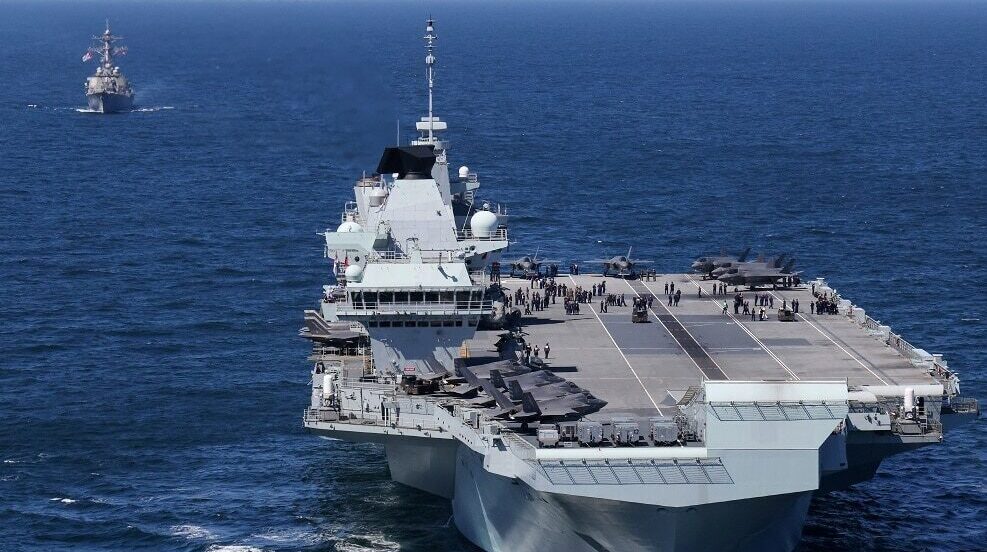| Introduction to the U.S. Navy |
| The U.S. Navy has long been a cornerstone of American military power, playing a crucial role in safeguarding the nation’s interests both at home and abroad. As one of the most powerful naval forces in the world, the Navy is involved in a wide range of operations from humanitarian missions to counterterrorism and strategic military exercises. In this article, we will explore the latest developments, challenges, and future trends within the U.S. Navy. |
| A Brief History of the U.S. Navy |
| Established in 1775, the U.S. Navy’s history is intertwined with the nation’s growth and global presence. From the Revolutionary War to its role in modern conflicts, the Navy has been a dominant force in shaping U.S. foreign policy and maintaining freedom of navigation across the world’s oceans. Its evolution has mirrored the changing needs of global security, from large-scale naval battles to high-tech operations. |
| The Role of the U.S. Navy in Global Security |
| The U.S. Navy is a key player in maintaining maritime stability and deterring conflicts globally. With a fleet of advanced ships, submarines, and aircraft, it ensures the free flow of goods through strategic waterways and supports U.S. allies and partners in defending their territories. The Navy’s role has expanded over the decades to include humanitarian aid, anti-piracy operations, and counterterrorism efforts. |
| Recent News on the U.S. Navy |
| New Naval Ships and Technologies |
| One of the most exciting developments in the U.S. Navy is the commissioning of new ships designed to adapt to modern warfare. The USS Delaware, an advanced Virginia-class submarine, was recently launched, offering cutting-edge technology and stealth capabilities. Similarly, the introduction of new warships, such as the Zumwalt-class destroyers, signals a shift toward high-tech, multi-functional naval platforms that will be crucial in future conflicts. |
| U.S. Navy Operations in the Indo-Pacific Region |
| The Indo-Pacific region has become a key area of focus for the U.S. Navy, especially with the growing influence of China in the South China Sea. In response, the U.S. Navy has increased its presence in the region, conducting regular patrols and participating in joint military exercises with allies like Japan, South Korea, and Australia. The presence of the Navy serves not only as a deterrent against aggression but also reinforces U.S. commitments to regional stability. |
| Tensions with China and the South China Sea |
| The South China Sea remains a hotbed of geopolitical tensions, particularly between China and its neighboring countries, many of whom have territorial claims. The U.S. Navy’s Freedom of Navigation operations challenge China’s territorial claims, asserting the right of all nations to navigate these critical waters. These operations, which often involve aircraft carriers and destroyers, highlight the Navy’s strategic importance in countering China’s growing maritime ambitions. |
| The Navy’s Presence in Strategic Waterways |
| Beyond the South China Sea, the Navy has maintained a constant presence in other strategic regions such as the Persian Gulf, the Arctic, and the Mediterranean. This strategic positioning enables the U.S. to maintain influence and safeguard shipping lanes, which are vital for global trade. Additionally, the Navy’s presence in these regions acts as a deterrent to potential adversaries looking to disrupt international peace and commerce. |
| U.S. Navy’s Response to Global Crises |
| The U.S. Navy plays a crucial role in responding to global crises, whether natural disasters or man-made conflicts. In recent months, the txbrief.com has been involved in disaster relief efforts in places like the Caribbean after hurricanes and in Asia following earthquakes. With its extensive fleet of hospital ships, amphibious assault ships, and personnel trained in emergency operations, the Navy is often among the first responders to provide humanitarian assistance. |
| Humanitarian Missions and Disaster Relief Efforts |
| The Navy’s humanitarian missions have been wide-ranging, from providing medical aid to refugees in Africa to bringing food and supplies to communities devastated by natural disasters. The Navy’s hospital ships, such as the USNS Mercy, have been deployed to areas in need, offering medical care and resources that are often unavailable in crisis zones. |
| Military Exercises and Joint Operations |
| The U.S. Navy also participates in numerous joint military exercises with allied forces worldwide. These exercises help strengthen international partnerships, improve operational readiness, and ensure that the Navy is prepared for a wide variety of contingencies. Recent exercises have focused on anti-submarine warfare, amphibious assault operations, and integrated air-defense systems. |
| The Future of the U.S. Navy |
| Emerging Naval Technologies and Innovation |
| The U.S. Navy is embracing emerging technologies to stay ahead of potential threats. One of the most exciting innovations is the development of autonomous vessels and drones, which promise to change the landscape of naval operations. These unmanned systems can perform surveillance, reconnaissance, and even combat missions, reducing risk to human life and enhancing operational efficiency. |
| Autonomous Vessels and Artificial Intelligence |
| Autonomous vessels, such as the Ghost Fleet, are being developed by the U.S. Navy as part of its long-term strategy to reduce crew size and enhance the ability to operate in contested environments. Artificial Intelligence is being integrated into the Navy’s operational framework to assist in decision-making processes, allowing for faster and more accurate responses in high-pressure situations. |
| Advancements in Naval Weapons Systems |
| The Navy is also focusing on improving its weapons systems. From hypersonic missiles to laser weapons, these advancements are designed to enhance the Navy’s ability to respond to modern threats. Hypersonic missiles, for example, can travel at speeds greater than Mach 5, making them difficult to intercept and providing the Navy with a powerful strike capability. |
| Naval Strategy and Global Security |
| The Navy’s strategy for the future is focused on maintaining freedom of navigation, countering threats from near-peer adversaries like China and Russia, and ensuring global maritime security. The Navy’s evolving strategy emphasizes mobility, flexibility, and adaptability to meet the challenges of an increasingly complex world. |
| Modernizing Fleet Capabilities for Future Threats |
| As global threats continue to evolve, the Navy is working to modernize its fleet. This includes upgrading existing vessels with new technologies, such as advanced radar systems and electronic warfare capabilities. The goal is to ensure that the fleet remains ready to face future challenges, including cyber threats and advanced weaponry. |
| The Role of the Navy in Countering Cyber Warfare |
| In an age of cyber warfare, the U.S. Navy is prioritizing the protection of its digital infrastructure. Naval forces are being trained to defend against cyberattacks, and the Navy has developed offensive cyber capabilities to neutralize adversaries who target critical systems. This focus on cybersecurity is essential in safeguarding national defense. |
| Challenges Facing the U.S. Navy Today |
| Rising Costs and Budget Constraints |
| One of the major challenges facing the U.S. Navy is the rising cost of maintaining and modernizing its fleet. The price of building new ships, upgrading weapons systems, and investing in research and development has put pressure on the Navy’s budget. Balancing the need for a modernized force with financial limitations will be a key issue for the Navy in the years to come. |
| Recruitment and Retention Challenges |
| The U.S. Navy is facing challenges in recruiting and retaining personnel, especially as the military competes with the private sector for talented individuals. Efforts to improve benefits, enhance work-life balance, and create a more inclusive environment are all part of the Navy’s strategy to address these challenges. |
| The Impact of Personnel Shortages on Navy Readiness |
| Shortages in personnel can impact the Navy’s ability to maintain readiness and carry out missions. To address this, the Navy is exploring new recruitment strategies and providing additional training and incentives for personnel. |
| Diversity and Inclusion Initiatives in the U.S. Navy |
| The Navy is also making strides in promoting diversity and inclusion within its ranks. These efforts include outreach programs to underrepresented communities and initiatives to create a more inclusive workplace for sailors. |
| The U.S. Navy’s Role in National Defense |
| Protecting American Interests and Promoting Stability |
| The Navy continues to play a crucial role in protecting American interests both domestically and internationally. Through its global presence, the Navy helps prevent conflicts and ensures that the U.S. can project power worldwide. |
| The Navy’s Role in Global Maritime Security |
| With the majority of global trade being transported by sea, the Navy plays a vital role in maintaining maritime security. Its ability to secure shipping lanes ensures that goods continue to flow across the world, preventing piracy and illegal activities on the high seas. |
| Conclusion: Looking Ahead to the Future of the U.S. Navy |
| As the U.S. Navy faces both new challenges and opportunities, it remains a cornerstone of the nation’s defense strategy. By embracing new technologies, modernizing its fleet, and tackling personnel and budget challenges, the Navy is positioning itself for continued success in the 21st century. |








_3-6.jpg)
